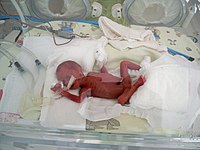
Photo from wikipedia
Objective The objective of this study was to compare adverse pregnancy outcomes between fetuses with estimated fetal weight (EFW) < 10 to > 10% in women with preterm preeclampsia (PE)… Click to show full abstract
Objective The objective of this study was to compare adverse pregnancy outcomes between fetuses with estimated fetal weight (EFW) < 10 to > 10% in women with preterm preeclampsia (PE) with severe features. Materials and Methods All women with preterm PE with severe features and nonanomalous singletons with EFW were identified at a tertiary center. Women with oligohydramnios or absent/reversed umbilical Doppler velocimetry were excluded. Using multivariable analysis, we compared the composite maternal and neonatal morbidities (CMM and CNM) between those with appropriate for gestational age (AGA) fetal growth, defined as EFW at 10 to 90th versus those with fetal growth restriction (FGR), defined as EFW < 10th percentile for gestational age (GA). Results In this study, 165 patients were included; 112 had EFW at 10th to 90th percentile, and 53 had FGR. Of the 53 with FGR, 33 (62%) had EFW at 5 to 9% for GA and 20 (38%) had EFW < fifth percentile for GA. The CMM was significantly higher among women with FGR versus AGA (29 vs. 7%; p < 0.001). The CNM was significantly higher with FGR versus AGA (20 vs. 6%; p = 0.01). Conclusion Women with preterm PE with severe features and FGR, when compared with those with AGA, have significantly higher risk of CMM and CNM.
Journal Title: American Journal of Perinatology
Year Published: 2018
Link to full text (if available)
Share on Social Media: Sign Up to like & get
recommendations!